Have you ever heard of wet skimming in a saltwater aquarium? Maybe you have and maybe you haven’t but if you haven’t tried it, you should.
First off, I did not invent this concept. I have been utilizing it as a maintenance strategy in my aquarium maintenance company for over 5 years though.
Simply put, it is letting your skimmer overflow slightly so as to collect a more dilute skimmate. This is not meant to be the way it is set 24/7, just during a water change scenario. If you pull water right out of the aquarium and look at it in a white bucket, it should be pretty clear. Honestly, if it isn’t, you probably have water quality issues. However, If you wet skim into a white bucket, you’ll likely notice a yellow tint to the water and lots of persistent bubbles floating on the surface. You might be surprised that you can wet skim out really disgusting looking water from a really clean appearing, healthy reef aquarium. By the way, white buckets are best so you can get a good look at the discoloration of the water. If you can’t find a pure white bucket, get them HERE if you can”t find any at your local hardware store.

Wet skimmed bucket on the left, pulled straight out of the aquarium on the right.
In the picture below, you see a hose with a small ball valve on it coming from a skimmer cup and leading into the bucket. Notice how nasty the water is?
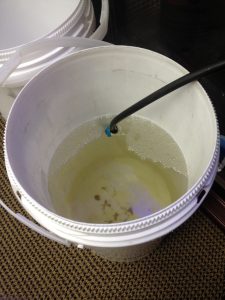
Believe it or not, it came out of this reef aquarium below.

280 gallon reef tank installed and maintained by Captive Aquatic Ecosystems
There are many considerations you will need to think over before you start wet skimming for water changes. If you raise or lower the water level in your sump temporarily, what might be effected? How much extra water could you add to your system before it would cause an overflow in your sump? Would lowering your water level expose probes that shouldn’t be exposed to the air? How far can you lower your sump level before your main pump sucks in air? Reef aquariums are all unique in their design and how they were set up. Each and every one of my clients’ systems are installed differently and my approach is different with each one. As I see it, there are two basic ways to wet skim; by flooding the system while modulating the amount of skimmate coming out of the skimmer and into waiting buckets (or a floor drain if you are lucky) or by shutting off your auto top-off system, wet skimming into buckets and adding new saltwater near the main pump BEFORE it starts to suck in air. By the way, don’t let water pumps suck in air; It’s not good for the longevity of the pump.
With high-tech controllers like the Neptune Apex, some reef tanks have gotten more complicated over the years so be sure to think through what a higher or lower water level in your sump might trigger or effect and take the necessary precautions.
Most skimmers have some sort of drain fitting on the cup. You’ll need several feet of quality 3/8″-1/2″ flexible hose leading from your cup drain, ending in a small ball valve so you can easily block the flow if you need to.My favorite hose to use here is available at Bulk Reef Supply and you can check it out by clicking HERE. I prefer this soft silicone tubing because it is easier to work with than the cheaper vinyl tubing available at hardware stores. The rigidity of vinyl tubing can sometimes make it frustrating to work with as you are fighting against kinks and loops that the material has a “memory” of. Silicone doesn’t do that.
For what it’s worth, you could buy enough flexible line to run out your front door and down your driveway if you wanted to. There are some situations where I was lucky enough to get a floor drain installed underneath an aquarium as a building/house was being built, which allows me to drain the skimmate as in the picture below.
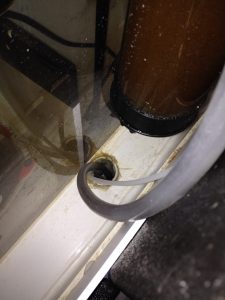
If your skimmer cup does not have a drain or the drain hole is too small for effective wet skimming, you can always just use something like a 4-5 foot long flexible hose (3/8″ -1/2″ OD tubing is usually all that is necessary) and some sort of small clamp to affix it to the cup rim. Lead the other end of the hose into a bucket or drain. You can attempt to match the amount skimming out with the ability of your drain hose to siphon out but realize that you will need to sit right there and occasionally adjust the skimmer’s internal level because the amount that the skimmer spits out will slowly decrease as the water level in the sump lowers. You could also add a small ball valve like THIS ONE (3/8″ silicone line with 3/8″ ball valve at the end is what I use in these cases). Don’t forget you would need to insert a barbed fitting into that push-to-connect ball valve. Click HERE for those barbed fittings. As you can see, it’s just easier to have a built-in drain nipple already on your skimmer cup. With a little bit of DIY spirit though, you can get around any situation. If you can’t figure it out, hit me up in the comment section and I will help you figure it out.
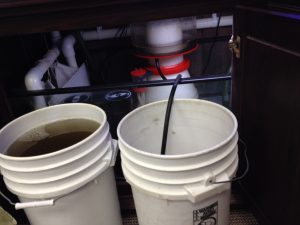
If you are going to flood your system a little at a time with new saltwater and skim out the excess until the level of your sump comes back down to normal operating level, don’t forget to start off by lowering your skimmer’s internal level all the way down before you add saltwater to the system. Gradually bring it back up until it is overflowing slightly. Keep an eye on your bucket as it fills because you obviously don’t want that nasty water dribbling onto your floor. You will need to stay right there with the skimmer and adjust it a bit as the water level in your sump comes back down to where it normally stays. Now you could add more new water in order to flood the system a little and continue modulating the skimmer discharge to allow you to wet skim the level back down. It may seem like a lot to keep track of at first but reefers are smart people and you’ll get the hang of it quickly.
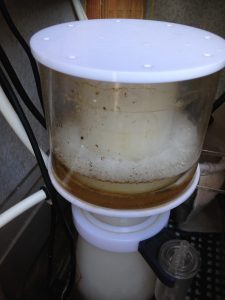
It makes more sense to kick debris up in your system before you do all this. Stir up the substrate, use a small circulation pump, turkey baster or your hand to stir up detritus, clean the algae from the viewing panes…all that. Then start wet skimming. You’ll be amazed at how much of this junk it pulls out and also how quickly wet skimming will clear all that up.
Another thing to think about is where to pour the new water while wet skimming. You’d like to avoid skimming out much new water as possible of course so you’ll generally either want to pour new water right into the middle of the tank or down below in the main pump chamber of your sump. You wouldn’t want to pour new water right by the skimmer as you may end up with some of that water making it’s way out of your system through the skimmer.
Don’t forget to disengage/turn off/unplug your automatic top-off equipment as you obviously wouldn’t want it adding freshwater while you are doing this.
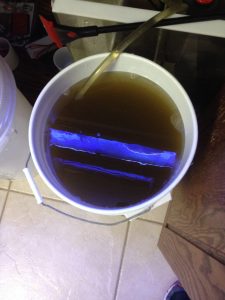
When I first started doing this, I thought I had the bright idea to clean inside the neck of a dirty skimmer as I was wet skimming. I thought maybe the skimmer would just puke it right out. Not so. Some of the gunk comes floating out into the cup but a lot is drawn down into the skimmer and ejected from the skimmer itself and into the sump. Now that is defeating the whole purpose and is obviously counter productive so pull the skimmer cup and clean it in a sink BEFORE you start wet skimming.
A skimmer works by creating tiny air bubbles that protein laden molecules stick to. Those nasty organic molecules are looking for an air/water interface because one side of the molecule is hydrophobic (hates water) while the other side is hydrophilic (loves water). That’s why you see a thin “oil slick” phenomenon on the surface of your water if you don’t have a protein skimmer or an aquarium with no overflow. That is the protein rich molecules finding that air/water interface. Hopefully you do have an overflow and a good protein skimmer…otherwise why did you even read this far?!? My writing is not THAT good or entertaining. Back to air bubbles, the dwell time of an air bubble inside a skimmer is important. The longer that air bubble swirls around inside that skimmer, the more dissolved organic molecules it picks up. This is often why it is hard to get a small skimmer that works well. A small skimmer kind of goes against the whole principle of dwell time. What I am getting at is the slower you make the skimmer overflow into a bucket, the more concentrated the gunk is going to be. You are going to have to decide how long you want this to take but my perspective is from a professional aquarium maintenance standpoint. I can’t wait around for 3 hours to clean an aquarium. I need to do a great job but I need to do it in a timely manner. Sure, wet skimming adds more time to my maintenance procedures but I find that the aquariums I maintain seem to get more benefit from what I believe is a greater removal of dissolved organics than just pulling water right out of the water column. From my standpoint, depending on the size of the aquarium and everything else I need to get done, I should be able to clean most reef aquariums in the ballpark of one hour. You have to decide how long you have to devote to cleaning your reef in this manner. I don’t believe it is something that you should feel you need to spend an inordinate amount of time doing but I think you will find that it is another method to get the results you are looking for.
Click on this link below for a quick video of some wet skimming action on a client’s reef.
Thank you for reading and please hit me up with any questions, comments, suggestions, stories or anything else pertaining to wet skimming your reef aquarium.
Ben Johnson – Captive Aquatic Ecosystems – 713-385-1297 – ben@caecosystems.com – custom aquarium installation and scheduled maintenance in Houston, Texas and beyond.

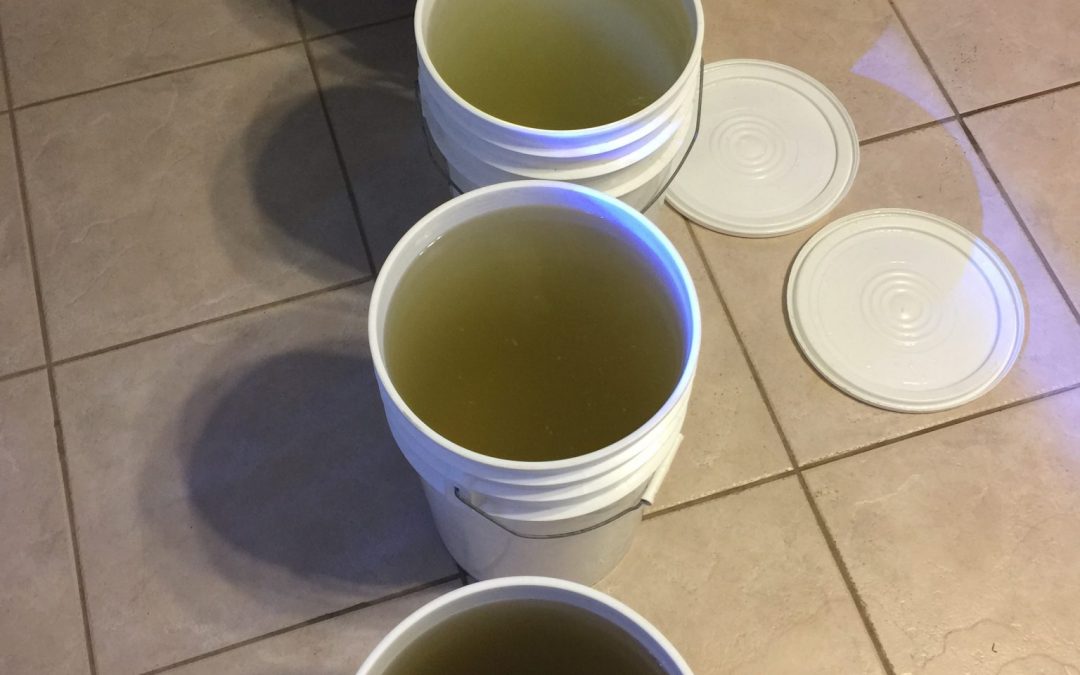
Ben, why not just move the ATO pump over to a bucket with fresh salt water during this process? Especially if it empties down stream of the skimmer. Think I might try it next time.
I dig it. This is a great idea.